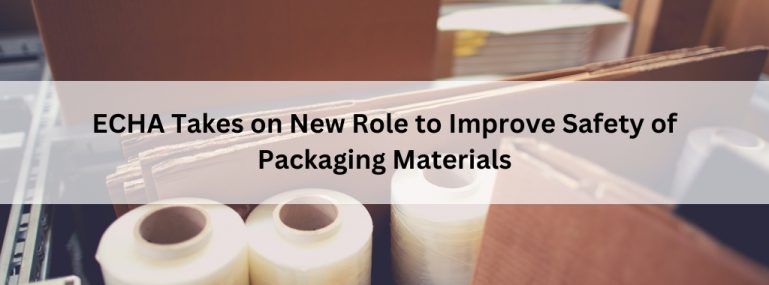The European Chemicals Agency (ECHA) is taking on a new mission to enhance packaging safety due to growing environmental concerns and increasing awareness of chemical risks. Packaging plays a crucial role in protecting products, ensuring durability, and facilitating transport. However, it also presents potential chemical hazards, especially for consumables and food. To mitigate these risks, ECHA aims to strengthen regulatory controls, reduce hazardous substances, and promote safer alternatives.
The Importance of Packaging Safety
While packaging is essential for maintaining product integrity, it also poses risks due to chemical migration. Toxic substances from packaging materials can leach into food, beverages, and personal care products, posing serious health threats.
Key concerns include:
- Endocrine Disruptors – Chemicals like phthalates and bisphenols that can interfere with hormonal systems.
- Heavy Metals – Found in coatings, inks, and recycled materials, these can accumulate in the body over time.
- Per- and polyfluoroalkyl substances (PFAS) – Used in grease-resistant packaging, but linked to long-term health issues.
With increasing scientific evidence and public pressure, regulators are intensifying efforts to reduce these risks.
ECHA’s Expanded Role in Packaging Safety
ECHA has long been at the forefront of chemical regulation in the EU, overseeing REACH (Registration, Evaluation, Authorisation, and Restriction of Chemicals) and CLP (Classification, Labelling, and Packaging) regulations. Now, under its expanded mission, ECHA is adopting a more proactive approach to packaging safety:
1.Assessing Hazardous Chemicals in Packaging:
- Identifying harmful compounds that pose risks to human health and the environment.
- Evaluating the safety of materials used in food-contact packaging.
2.Supporting the EU Packaging and Packaging Waste Regulation (PPWR):
- Ensuring packaging materials meet the latest safety and recycling standards.
- Encouraging sustainable alternatives to traditional packaging materials.
3.Strengthening Regulations and Restrictions:
- Expanding the list of restricted chemicals in packaging.
- Accelerating the removal of hazardous substances like PFAS from food packaging.
4.Enhancing Supply Chain Transparency and Accountability:
- Requiring manufacturers to disclose detailed chemical compositions of packaging materials.
- Promoting digital tracking and labelling for safer, more environmentally friendly packaging.
Impact on Businesses
Industries such as food, cosmetics, pharmaceuticals, and consumer products will be significantly affected by ECHA’s expanded role. Companies must:
- Reevaluate Material Choices: Transition to safer, compliant alternati
- Prepare for Stricter Regulations: Adapting to new material restrictions may require redesigning or modifying packaging.
- Enhance Supply Chain Transparency: Improving traceability and documentation of packaging components.
- Invest in Sustainable Solutions: As non-toxic, recycled materials gain popularity, companies must innovate to align with new EU standards.
Failure to comply could lead to supply chain disruptions, legal repercussions, and reputational damage.
Implications for Consumers
ECHA’s new role in packaging safety is a significant step forward for consumers, ensuring safer and healthier packaging. Over time, consumers can expect:
- Reduced Exposure to Harmful Chemicals: Stricter regulations will minimize the presence of hazardous substances in food and product packaging.
- More Sustainable Packaging Alternatives: Greater focus on recyclability and environmental impact in packaging design.
- Increased Transparency: Clearer labeling will make it easier to understand the safety and sustainability of packaging materials.
The Future of Packaging Safety
ECHA’s enhanced responsibilities align with broader EU initiatives such as the Circular Economy Action Plan and the European Green Deal, both of which prioritize waste reduction and chemical safety. Moving forward, businesses and regulators will collaborate to drive innovation in packaging materials and ensure compliance with evolving regulations.
To stay ahead, companies must swiftly adapt to these changes, meeting consumer expectations and regulatory demands. By adopting safer, more sustainable packaging solutions, businesses can enhance brand trust and contribute to a healthier, more environmentally friendly future.
The regulation of chemicals in packaging materials is undergoing a significant transformation with ECHA’s expanded role in ensuring packaging safety. This shift, which includes reducing hazardous substances, increasing transparency, and promoting sustainability, benefits both businesses and consumers. Companies should embrace innovation in packaging design and proactively adjust to tightening regulations. ComplianceXL supports its clients in navigating these regulatory changes under the EU Packaging Directive, helping them enhance their business operations.
FAQs:
1. What is ECHA’s new role in packaging safety?
The European Chemicals Agency (ECHA) is expanding its authority to evaluate and regulate hazardous substances in packaging. This includes assessing the safety of chemicals in food-contact materials, supporting the EU Packaging and Packaging Waste Regulation (PPWR), and tightening restrictions on harmful substances.
2. When will these new regulations take effect?
New packaging-related regulations under REACH and the PPWR are already being implemented. Companies should begin preparing now to comply with the upcoming changes.





